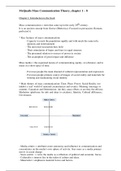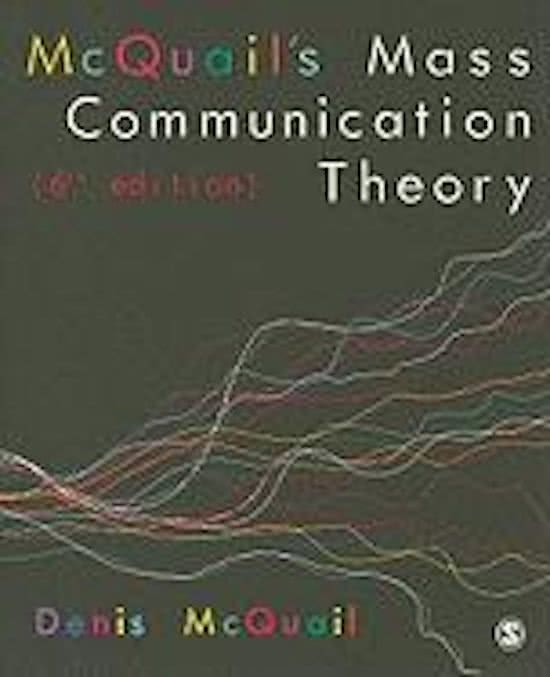McQuails Mass Communication Theory, chapter 1 – 8
Chapter 1: Introduction to the book
Mass communication = term that came up in the early 20th century.
It is an ancient concept from Greece (Rhetorica). Focused on persuasion. Romans
perfected it.
* Key features of mass communication:
- Capacity to reach the population rapidly and with much the same info,
opinions and entertainment
- The universal fascination they hold
- Their stimulation of hopes and fears in equal measure
- The presumed relation to sources of power in society
- The assumption of great impact and influence
Mass media = the organized means of communicating openly, at a distance, and to
many in a short space of time.
- For most people the main channel of cultural representation and expression
- For most people primary source of images of social reality and materials for
forming and maintaining social identity.
* Main themes of mass communication: Time; Place; Power; Social Reality (we
inhabit a 'real' world of material circumstances and events); Meaning (message or
content); Causation and Determinism (do they cause effects or are they the effects);
Mediation (platforms for info and ideas to circulate); Identity; Cultural difference;
Governance.
- Media-centric = attributes more autonomy and influence to communication and
concentrates on the media's own sphere of activity. Sees mass as a media primary
mover in social change.
- Socio-centric = views the media as a reflection of political and economic forces.
- Culturalist = interest lies in the realm of culture and ideas.
- Materialist = emphasize material forces and factors.
,- Media-culturalist perspective = takes the perspective of the audience member in
relation to some specific genre or example in media culture, explores subjective
meaning of the experience in context.
- Media-materialist approach = emphasizes the shaping of media content and therefore
of potential effects, by the nature of the medium in respect of the technology and the
social relations of reception and production that are implicated by this.
- Social-culturalist perspective = subordinates media and media experience to deeper
and more powerful forces affecting society and individuals.
- Social-materialist perspective = linked to a critical view of media ownership and
control.
* Five kinds of theory:
• Social scientific theory = general statements about the nature, working and
effects of mass communication, based on systematic and objective observation
of media and other sources.
• Cultural theory = seeking to differentiate cultural artifacts according to criteria
of quality.
• Normative theory = how media ought to operate with social values.
• Operational theory = practical ideas assembled and applied by media
practitioners of their own media work. Tries to give solutions to fundamental
tasks.
• Common-sense theory of media use = knowledge we all have.
Communication science = a science which seeks to understand the production,
processing and effects of symbol and signal systems by developing testable theories,
containing lawful generalizations, that explain phenomena associated with production,
processing and effects
Communication network = any set of interconnected points (persons or places) that
enable the transmission and exchange of information between them. There are different
levels (see schema).
Mass = entire society. Org = region, city, town, firm, profession which has not a single
location, institution. Intergroup = interest, need, activity, environment. Intragroup
/interpersonal = e.g. family, intrapersonal = how info is processed (learning, recall).
New is globalization of social life, which is a higher level. Network society = networks
are to an increasing degree not confined to any one level of society (e.g. internet = at
every level).
* Three main approaches in theory:
- Structural approach = focus on the effect of the social structure and media systems on
patterns of news and entertainment. Define reach and social composition of audience,
needed media to sell adds.
- Behavioral approach = interested in human behavior. First: the audience
conceptualized as exposed to influence or impact, audience is passive. Later: how is the
media being used with the audience viewed more as active.
- Cultural approach = questions of meaning and language, in-depth and qualitative
analysis. Use a reflection of a particular social-cultural context as a process of giving
meaning to cultural products and experiences in every day life.
,Chapter 2: The rise of mass media
Four elements are significant in the telling of the history of mass media, in the wider
life of society:
- Certain communicative purposes, needs or uses.
- Technological developments.
- Social development: forms of social organization that provide the skills and
frameworks for organizing production. E.g.: people learned how to read, a
growing need of information.
- Economical developments: industrialization, forms of regulation and control
- Political systems were born: polarization.
The more open a society, the more development in communication
technology there is. Three dimensions in the relation between
media and society:
- Material dimension: What purpose does the medium serve?
- Political dimension: How free is a medium?
- Normative or social-cultural dimension: What are the uses from the p.o.v. of
the individual.
* The book
Gradually a change in content - more secular, practical and popular works. First
not regarded as a means of communication, but of storing information. Library
came. Organized public info, mass medium.
Printing started the media institution = an organized set of interrelated activities
and roles, directed towards certain goals and governed by a set of rules and
procedures.
Late sixteenth century: start of the professional author, made the book a commodity.
And copyright. Later the book became greater in volume and range. Struggle for
freedom, no more gov't / church censorship: freedom of the press, together with
democratic political freedom.
th
Key features of the book as a medium since the 16 century:
Medium aspects:
- Technology of movable type
- Bound pages, codes form
- Multiple copies
- For personal reading
- Individual authorship
Institutional aspects:
- Commodity form
- Market distribution
- Diversity of content and form
- Claim to freedom of publication
- Subject to some legal limits
* The Newspaper - Public character
The early newspaper:
- Regular appearance
- Commercial basis
, Used for information, record, advertising, diversion and gossip. Adversary of
established power, especially in its own self-perception. Identified with its intended
readers.
Professional journalism: 20 th century, true mass medium. Genres:
- Party-political press = dedicated to activation, info and organization. Lost
grounds to commercial press.
- Prestige press = 1850-1900, high bourgeois. Product of liberalism, no censorship,
high sense of social and ethical responsibility, objective, during time of business
professionalization and socio and tech changes.
- Popular press = true mass newspaper, commercial. Made possible by advances in
tech of scale, concentrations of population, the spread of literacy and large amounts of
advertising revenue. Later: tabloidization = process of become more sensational, trivial
and irresponsible.
- Local and regional press = consensual and bipartisan approach, dependence on local
advertisers.
New journalism: new topics, new genres, larger audience, new audience groups, more
regional and local coverage, news industry became a profitable business.
Professionalization of journalism: more status, press card, important politicians,
masters of industry, important literary figures, specialized education, books and
magazines on the topic, journalistic ideals and methods, regional and local journalists,
So, steady progress towards more press freedom.
* Other print media
Weekly/monthly magazine: 18th century, great diversity. Developed eventually
into a mass market of high commercial value. The alternative periodical was for
resistance and expression of minority movements.
* Film
Instantly a true mass medium. Met the needs of the people: fill leisure time in safe,
affordable and sociable way. Propaganda films were popular, still lots of propagandist
elements in entertainment films. Films are vulnerable to outside interference (9/11).
Americanization of the film industry after WWI. Separation between film and cinema
with the start of television, DVD, etc. Film is a mass culture creator.
* Broadcasting (radio + television)
Both were a technology looking for a use, no response to a demand. Both high degree
of regulation, control or licensing by public authority. Was thought to be too powerful
to be in the hands of one. Public needs protection from potential harm or manipulation.
Centralized pattern of distribution, no return flow. Window of the world. Sense of
intimacy and personal involvement, seems to cultivate between spectator and presenter.
Considered to be the main source of information and news, main channel for political
communication. Most ads.
* Recorded music
Started in 1880, no discontinuities, only change in genre and fashion. Now the industry
is interrelated and concentrated in ownership. Key features medium: Sound experience,
personal satisfaction, main appeal to youth, mobile, flexible in use. Key features
institutional: low degree of regulation, high degree of internationalization, multiple
technologies and platforms, links to major media industry, organizational fragmentation,
and central to youth culture.






